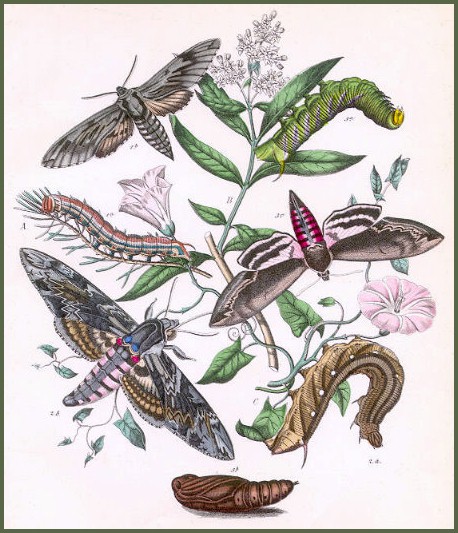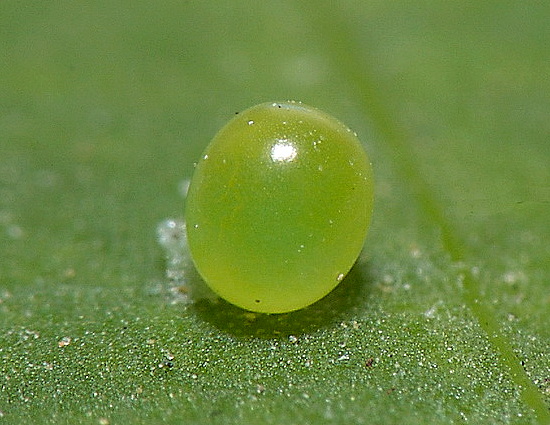UK: Convolvulus hawkmoth, F: Sphinx du Liseron, D: Windenschwärmer; Weidenschwärmer, RUS: Vyunkovyi Brazhnik, S: Åkervinde-Svärmare, NL: Windepijlstaart, CZ: Lišaj svlačcový, H: folyófüszender, E: esfinge de las enredadores, PL: Zawisak powojowiec, FIN: Kiertokiitäjä, I: sfinge del convolvolo, HR: slakov ljiljak, DK: Snerlesværmer, N: Vindelsvermer, EST: Kassitapusuru.
Sphinx convolvuli Linnaeus, 1758, Syst. Nat. (Edn 10) 1: 490.Type locality: [Europe].
[Further details on this species, as well as photos of all stages, can be found on Lepiforum.]



Palaeotropical and Australasian.


Wingspan: 95--130mm. Sexually dimorphic; female often considerably larger than male. Ground colour of forewing light to dark grey, with dark patches and markings which can be either extensive or absent. This large moth can be confused with no other sphingid of the region, except Agrius cingulatus (Fabricius, 1775), which has pink at the base of the hindwings. However, some specimens have yellow abdominal 'ribs' (f. pseudoconvolvuli Schaufuss), hence resembling North American Manduca species. Additionally, a very pale, almost white, high montane form occurs in the Tian Shan and Pamirs (f. aksuensis O. Bang-Haas).
In the male genitalia, uncus dilated before apex. Harpe with two upwardly curved processes; ventral process spatulate (shape diagnostic within the genus). In the female genitalia, antevaginal plate membranous, with a very thin medial flap arising from an impression anterior to ostium bursae. Ostium bursae flanked on either side by a tubercle, with another arising posteriorly.




This species, being a great migrant, penetrates further north and in greater quantities than Acherontia atropos (Linnaeus, 1758); in warm years this may involve huge numbers. However, as it is more sensitive to cold than Acherontia atropos, far fewer pupae manage to survive European winters. It shows a preference for warm open areas, i.e. agricultural steppes, but can be found almost anywhere except dense forest. Outside its resident range, it is particularly attracted to potato fields and, in suburbs, to flower-beds and hedges overgrown with Convolvulus. Adults rest during the day on any solid surface, especially tree-trunks, fences, telegraph poles or bare earth. With wings folded roof-like over the body, they resemble a piece of weathered grey wood and are hence difficult to detect. Sometimes pairs can be found in such locations, but most, having paired towards midnight, part before dawn. At other times, Agrius convolvuli is an extremely active and powerful flier, frequenting beds of tubular flowers, such as Nicotiana, Petunia, Lilium, Phlox and Jasminum, hovering between one blossom and another while probing with its very long proboscis (up to 130mm). This species is the main pollinator of the highly scented coastal Sea daffodil (Pancratium maritimum L.) around the Mediterranean. While on the wing between dusk and midnight, neither rain nor wind seem to deter this species. Light is also very attractive, most individuals arriving about two hours after dark.

Migrant and multivoltine; in its resident range, from April to October, with up to four well-defined generations. Farther north, migrants start arriving from June to August, producing an autumn generation during August and September, individuals of which are considerably larger in size than African specimens. There is some evidence for a southward migration in the autumn (Alkemeier & Gatter, 1990). [More information on the lifecycle in Europe can be found in Dvořák, 2017]
OVUM: Almost spherical, and very small for the size of the moth (1.30 x 1.15mm). Bright, glossy blue-green when laid, changing to yellowish green. Most are deposited singly on the upper and underside of the leaves of the hostplant, often in large numbers over a wide area. Each female can oviposit up to 200 eggs which hatch within 10 to 15 days, partially collapsing before doing so.

LARVA: Full-fed 100--110mm. Trimorphic: green, brown or yellow.










On hatching, the thin, 3--4mm long larva leaves its eggshell and immediately selects a resting place beneath a nearby leaf. Initially glaucous with a straight black-tipped horn, it gradually acquires a light green coloration through feeding. In the early stages, this involves nibbling holes through the leaf; little food is consumed and growth is slow. In the second and third instar, the ground colour deepens further, and pale yellow lateral stripes appear. By the fourth instar much more food is eaten, both by day and night, and growth is noticeably more rapid. Colour forms manifest themselves at this time, i.e. green, brown and, occasionally, yellow. A few totally black individuals are also known (Jean Haxaire, pers. obs. 2018). When fully grown, most hide themselves by day, only emerging to feed at night, although some make no attempt at concealing themselves, but rest stretched out on the ground or on a stem, with the first two segments partly withdrawn into the third.
All are extremely sluggish, moving only enough to reach a new leaf after one has been consumed. By contrast, when a pupation site is sought, some larvae have been known to wander rapidly for several hundred metres. Prior to pupation, larvae anoint themselves (see also Acherontia atropos). (For more information see Harbich (1980b).)
In its resident range, larvae are found from April to November; farther north during July, August and September.
Major Hostplants. Species of Convolvulus, Calystegia and Ipomoea; also other Convolvulaceae. In the Dead Sea area of Israel the main host is Zygophyllum dumosum (Müller et al., 2005b).
Minor Hostplants. Phaseolus, Chrysanthemum, Helianthus, Polygonum and Rumex. Also Orthosiphon and Zygophyllum in eastern Kazakhstan (Toropov, Milko, Zhdanko & Evdoshenko, 2023).
PUPA: 50--60mm, 12mm wide; tongue-sheath about 13.5mm long.



Colour a rich, glossy, mahogany\leather brown, with a large, distinctive, 'jug-handle' proboscis. Rather slender, head small, frons at right angles to the longitudinal axis of the body. Tongue reaching tip of wing-case, in a free sheath which starts from the front of head at right angles to body, curves backwards till parallel with the body and then forwards again to touch the ventral surface of the pupa, the slightly bulbous end being near the base of the eye. Dorsum of segment 2 slightly notched. Antenna about 1.5mm wide, but shorter than fore leg, with a long, narrow coxal piece. Surface shiny; abdomen finely pitted, the margins of the abdominal segments more coarsely pitted. Sculpturing on segment 4 pear-shaped, raised, with a polished area on each side of the dorsal line, the broad ends ventrad and reaching to about the dorso-lateral line. Veins of wings slightly raised; ante-spiracular ridges on abdominal segments 9 to 11, with three course ridges on each. Spiracles oval, rising slightly from shallow depressions, that of segment 2 covered by a short wide lobe extending from the front margin of 3. Cremaster conical, long and stout, with conical teeth (Bell & Scott, 1937).
Very sensitive and mobile, twitching violently if disturbed. Formed in a smooth-sided, hollow chamber in soft damp soil up to 10--20cm deep. The main overwintering stage throughout its resident range but rarely survives European winters.
Ichneumonidae: Amblyjoppa fuscipennis (Wesmael, 1845), Callajoppa exaltatoria (Panzer, 1804), Netelia vinulae (Scopoli, 1763); Trichogrammatidae: Trichogramma euproctidis (Girault, 1911); Tachinidae: Drino (Zygobothria) atropivora (Robineau-Desvoidy, 1830), Drino (Zygobothria) ciliata (Wulp, 1881) (Whitcombe & Erzinclioglu, 1989), Masicera sphingivora (Robineau-Desvoidy, 1830).

In September 2006, eggs and larvae of this species collected in Var Province, France, were found to be heavily parasitized by, respectively, Trichogramma euproctidis and Masicera sphingivora (Roger Perkins/B. Pintureau, pers. comm. 2006).


Resident only in the warmest areas of the western Palaearctic, but as a migrant to almost the entire region. Recorded as far north as Yaksha in european Russia (Tatarinov, Sedykh & Dolgin, 2003), and as far west as Ireland (Stendall, 1946) and the Azores (Vieira, 2003; Vieira et al., 2022). It is one of only three species of sphingid recorded from Iceland (Wolff, 1971) and, in the exceptional years of 2022 and 2023, numerous adults and larvae were found in the UK and the Netherlands.
Extra-limital range. The entire tropical and subtropical Old World, including Ascension Island and many Pacific islands -- Tahiti, Marshall Islands etc., and Indian Ocean Islands, e.g. the Seychelles (Bolotov, Kolosova, Spitsyna & Spitsyn, 2021). Absent from higher altitudes and more northern latitudes (to which it migrates), and a large portion of Siberia; however, it is recorded from the Russian Far East as an annual migrant (Izerskiy, 1999) north to the Kurile Islands.
In western Siberia and adjacent countries it is recorded only sporadically. Thus for Mongolia the species is only known from one unique specimen collected in the Trans-Altai Gobi (Yakovlev et al., 2015). It is regularly found in the Omsk region (Lavrov, 1927; Knyazev, 2020), and there are records from near Barnaul in the Altai Krai (Zolotarenko, Petrova & Shiryaev, 1978; Yakovlev & Volgin, 2020). However, it has not been reliably recorded from other territories, such as Novosibirsk, Kemerovo region, Tomsk region, Altai Republics, Tuva, and Khakassia (Yakovlev & Volgin, 2020).

None.
 Return to species list
Return to species list